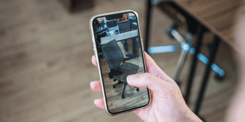If you’re feeling skeptical about whether or not 2018 is going to be the year of VR, you come by that skepticism honestly. VR has been plagued with over-hype, both from the press and headset makers. But, over the last 18 months, VR has ridden the hype cycle and we believe, come out the other side. Yulio clients have integrated VR into their practices and are on their way to it being an indispensable tool.
VR may not change your life yet - but it will change your business.
If you are still thinking VR is a transient fad and you can wait for it to pass...start thinking about it as a compelling technology that’s found it’s perfect time to shine. To help you get your head around the possibilities, here are a few stats we’ve rounded up from recent VR research we think you should see.
5 Years
Although in some form or other, VR has existed for several decades, the current boom in the technology was spawned by the Kickstarter campaign initiated just 5 short years ago by a little-known startup Oculus Rift. Oculus only ever sold (via Kickstarter) headsets as developer kits, but it still shifted 100,000.
A $2 billion acquisition later, and VR found its mojo, winning an ever-growing number of hearts, minds and new users across the globe.
11 Million+
Approximately 11 million virtual reality headsets were shipped in 2016, increasing to over 13 million in 2017.
51%
Over half of the U.S. population is aware of virtual reality devices and 22.4 million Americans are already VR users.
171 Million
Globally, right now, as I write, there are an estimated 171 million VR users.
$12.1 Billion
According to Statista, this very year, the virtual reality market is estimated to reach a value of 12.1 billion U.S. dollars. You think that’s a large number? You should see the next one.
$40.4 Billion
The projected VR software and hardware market is expected to reach $40.4 billion by 2020. That’s a lot of people using a lot of VR technology for a lot of different applications. By ‘a lot’, I mean ...
1 Billion +
… Over one billion people will regularly access VR and AR content by 2020.
Yes, that’s a ‘billion’ people. IDC predicted last year that the compelling combination of virtual reality and augmented reality content will have a global audience that tops this crazy number by the turn of the next decade. Mental note - this must mean VR is no fad.
41%
Those still on the fence don’t plan to be for long. According to Google’s Consumer Survey conducted last year, more than a third of the adults said that they would give virtual reality a try if they had the chance to. Consumer interest is set to continue pursuing VR as one of the most emerging technologies.
44%
Who will make up the next wave of buyers? Millennials … and lots of them. According to Nielson, 44 percent of people interested in purchasing VR devices are between the ages of 18 and 34. This generation is one heavily motivated by innovative devices and will play a major role in defining what ‘sticks’.
250
To satiate that desire to get involved in VR, there are currently 250 VR headsets styles available for purchase on Amazon.com.
82 million
By all accounts, they’re selling well as, according to Statistic Brain, there are expected to be 82 million headsets in use by 2020.
90%
Of all those headsets sold worldwide, approximately 90% are mobile phone based. What does this tell you? Best to make all of your VR applications and content very mobile friendly.
So what can be garnered from all the big numbers in our virtual reality research? VR is here to stay. It might not have always mirrored the hype, but it is unquestionably a growing force to be reckoned with.
Our advice? Don’t be alarmed. Fortunately, it’s not too late to get in on the VR game. It is, however, high time to get started.
To try VR for yourself, sign up for our 30-day free trial and wow your colleagues with this pre-packed presentation full of our VR research on the state of the industry.





.jpg?width=245&height=150&name=active-adult-beautiful-1799244%20(1).jpg)
